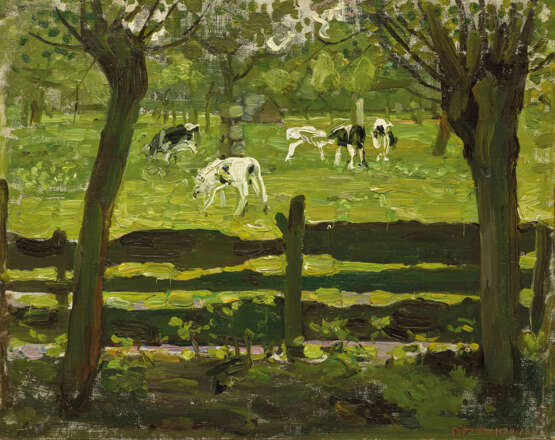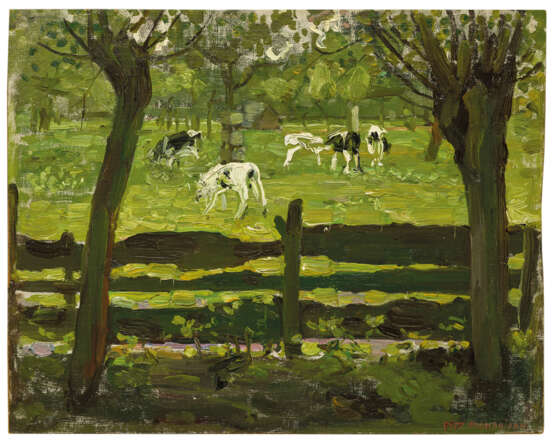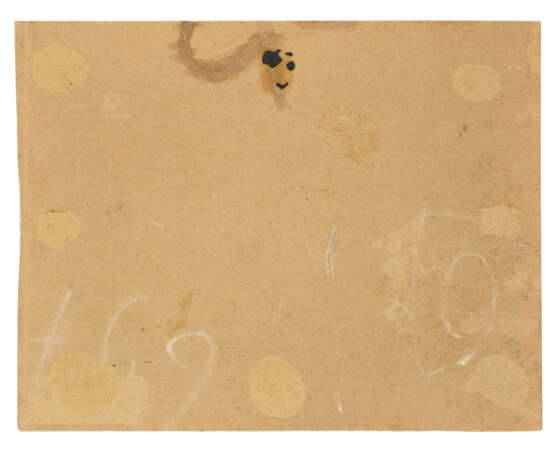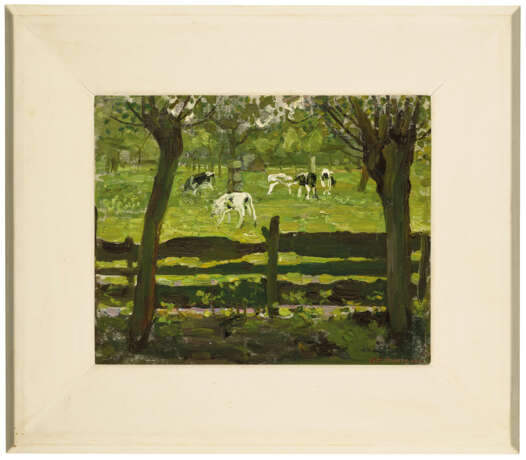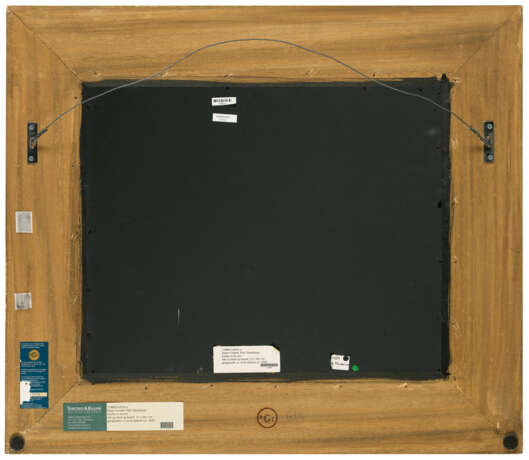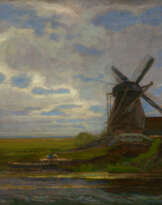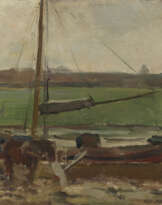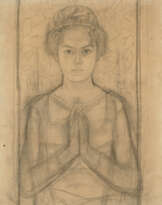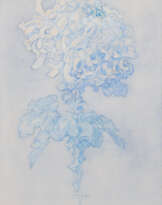ID 1400215
Los 330 | Piet Mondrian (1872-1944)
Schätzwert
€ 80 000 – 120 000
Vaches sur le pré
signé 'PIET MONDRIAAN' (en bas à droite)
huile sur toile marouflée sur carton
30.8 x 39 cm.
Peint en 1905
signed 'PIET MONDRIAAN' (lower right)
oil on canvas laid down on board
12 1/8 x 15 3/8 in.
Painted in 1905
Provenance
Collection B. M. Kramer, Amersfoort (avant 1955).
Vente, Parke-Bernet Galleries, New York, 27 mars 1963, lot 39.
Collection particulière, États-Unis; vente, Christie’s, Amsterdam, 8 décembre 1993, lot 221.
Collection particulière, Pays-Bas (acquis au cours de cette vente).
Collection particulière, Belgique; vente, Christie’s, Amsterdam, 5 juin 2007, lot 31.
Simonis & Buunk, Ede (acquis au cours de cette vente).
Acquis auprès de ceux-ci par le propriétaire actuel vers 2007-08.
Literature
M. Seuphor, Piet Mondrian, Life and Work, New York, 1955, p. 412, no. 36.
C. Blok, Piet Mondriaan, Een catalogus van zijn werk in Nederlands openbaar bezit, Amsterdam, 1974, p. 172.
C. Bloktamp, Mondrian, The Art of Destruction, Londres, 1994, p. 252, no. 14 (illustré en couleurs, p. 33).
R. P. Welsh, Piet Mondrian, Catalogue Raisonné of the Naturalistic Works (until early 1911), New York, 1998, p. 284, no. A338 (illustré et illustré en couleurs, p. 50).
Further details
« En 1905, Mondrian découvre Van Gogh, qui a compris et poussé à l'extrême l’ « individualité » et l' « étude fidèle et naïve ». Mondrian apprécie cet élan, mais se refuse à s'y conformer, car la théorie lui prescrit de suivre sa propre route. La beauté ne peut être dévoilée qu'expérimentalement, dans le tableau parfait. Dans l'intervalle, il a acquis une technique particulièrement maîtrisée. En plus d'être un virtuose du dessin, il se fie toujours davantage à son savoir-faire et à son intuition pour laisser libre cours à ses couleurs. [….] Le mouvement, ou l'activité humaine, n'y joue aucun rôle. La pureté de l'image l'emporte. Plus cette image est transparente et virginale, plus le regard peut s'y perdre. » (H. Janssen, ‘L’évolution de Piet Mondrian’, in Mondrian figuratif, cat. exp., Musée Marmottan Monet, Paris, 2019, p. 27.).
Vers 1870, un groupe de jeunes artistes révolutionnait la peinture néerlandaise en balayant d'un revers de main les motifs idylliques de l'époque romantique, au profit d'un style plus naturaliste. Ancrés dans le monde réel, leurs paysages se peuplèrent de moulins, de canaux, de champs fleuris, d'églises et de villages, emblématiques du terroir et des vastes étendues des Pays-Bas. L'œuvre tout entière de Mondrian trouve ses racines dans ce contexte artistique.
Initié à la peinture dès son plus jeune âge par un père professeur de dessin et un oncle artiste de profession, Mondrian intègre en 1892 l'académie des Beaux-Arts d'Amsterdam. Réalisé en 1905, Vaches sur le pré témoigne de l'intérêt qu'il porte alors au style impressionniste de l'École de la Haye, tout en préfigurant les recherches qu'il mènera plus tard avec l'expression abstraite.
Avec ses riches empâtements et sa palette brute aux couleurs de l'idéal pastoral, ce tableau révèle, déjà, une approche singulière du paysage, genre dominant de la tradition néerlandaise que Mondrian a longtemps cherché à revitaliser au gré de sa démarche radicale. Profondément habité par les formes et les éléments du monde naturel, il ne cessera de revisiter, remodeler, bouleverser le concept de paysage tout au long de sa carrière, poussant toujours plus loin les limites de la représentation vers des territoires abstraits, jusqu'à son apothéose avec ses œuvres De Stijl.
Dans cette œuvre, Mondrian dissémine çà et là de vifs empâtements blancs qui viennent illuminer l'ensemble et contrebalancer les tons plus sourds de la végétation brune et verte. Scindant la composition, les deux arbres au premier plan captent le regard de l'observateur et l'entraînent vers le ciel en suivant les courbes des branches, nerveuses et très expressives par rapport au rendu beaucoup plus fluide du pâturage en toile de fond. En disposant soigneusement son paysage à l'intérieur de ce cadre organique, Mondrian exalte son intérêt pour les possibilités artistiques offertes par la nature.
Peinte à une époque charnière de sa trajectoire de peintre, Vaches sur le pré est le théâtre d'une grande transformation, où l'on voit Mondrian s'éloigner progressivement de la figuration – et d'une volonté très impressionniste de saisir dans le monde extérieur les effets variables de la lumière à différents moments du jour –, pour se tourner vers une simplification de la forme, annonciatrice du dépouillement abstrait de ses années ultérieures.
“In 1905, Mondrian discovered Van Gogh, who had understood and pushed to the extreme "individuality" and "faithful and naive study." Mondrian appreciated this impulse, but refused to conform to it, because the theory prescribed that he follows his own path. Beauty can only be revealed experimentally, in the perfect painting. In the meantime, he had acquired a particularly mastered technique. In addition to being a virtuoso of drawing, he relied increasingly on his skill and intuition to give free rein to his colours. [….] Movement, or human activity, plays no role. The purity of the image prevails. The more transparent and virginal this image is, the more the eye can get lost in it.” (H. Janssen, ‘L’évolution de Piet Mondrian’, quoted in Mondrian figuratif, exh. cat., Musée Marmottan Monet, Paris, 2019, p. 27.).
Around 1870, a group of young artists revolutionized Dutch painting, rejecting the idealized subjects of the Romantic era in favor of a more realistic painting style. Landscape paintings depicted windmills, canals, flowers, churches and villages, set in the typical flat Dutch landscape. The origins of Mondrian’s painting lie in this context.
Mondrian was introduced to painting from an early age, his father was a qualified drawing teacher and his uncle an artist, and in 1892 he entered the Academy for Fine Art in Amsterdam. Dating from 1905, Vaches sur le pré reflects Mondrian’s interest in Dutch Impressionism, a style championed by the Hague School, whilst anticipating the artist’s later experimentations with abstraction.
With its thick impastos and earthy palette employed to represent a pastoral idyll, the present painting reflects the artist’s unique exploration of the landscape genre. Having long held an important role within the history of Dutch painting, Mondrian sought to revitalize the traditional genre of landscape painting, infusing it with his own radical ideas. Inspired by the natural world around him, Mondrian would continue to mine the genre for the rest of his career, pushing the boundaries of traditional painterly representation into the realms of abstraction and culminating in the De Stijl paintings with which his name is now synonymous.
In the present painting, Mondrian applies accents of white pigment to infuse the scene with light and offset the earthy tones of the grass and trees. Bisecting the composition, the two central trees hold the viewer’s gaze and lifts it skywards and along expressively rendered branches that counter the soft brushstrokes of the grass and foliage. By carefully arranging the landscape using this geometric framework, Mondrian conveys his interest in the painterly possibilities afforded by the natural world. It is here in Vaches sur le pré that one can see the artist moving away from mimetic representation, and from the Impressionists’ desire to capture a landscape under changing light conditions, and towards a simplification of form that anticipates the artist’s later abstract experiments.
| Künstler: | Piet Mondrian (1872 - 1944) |
|---|---|
| Angewandte Technik: | Öl auf Leinwand |
| Kategorie des Auktionshauses: | Gemälde, Aquarelle, Zeichnungen, Gemälde |
| Künstler: | Piet Mondrian (1872 - 1944) |
|---|---|
| Angewandte Technik: | Öl auf Leinwand |
| Kategorie des Auktionshauses: | Gemälde, Aquarelle, Zeichnungen, Gemälde |
| Adresse der Versteigerung |
CHRISTIE'S 8 King Street, St. James's SW1Y 6QT London Vereinigtes Königreich | |
|---|---|---|
| Vorschau |
| |
| Telefon | +44 (0)20 7839 9060 | |
| Aufgeld | see on Website | |
| Nutzungsbedingungen | Nutzungsbedingungen |
